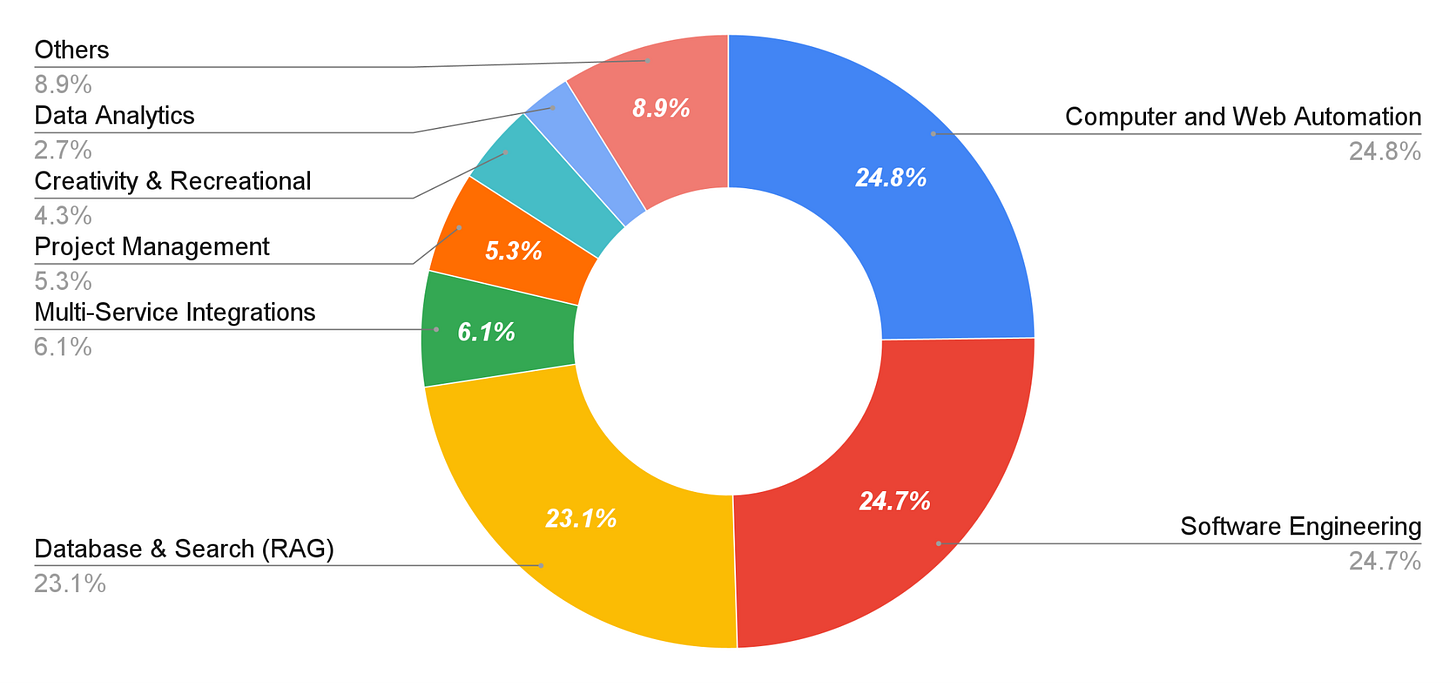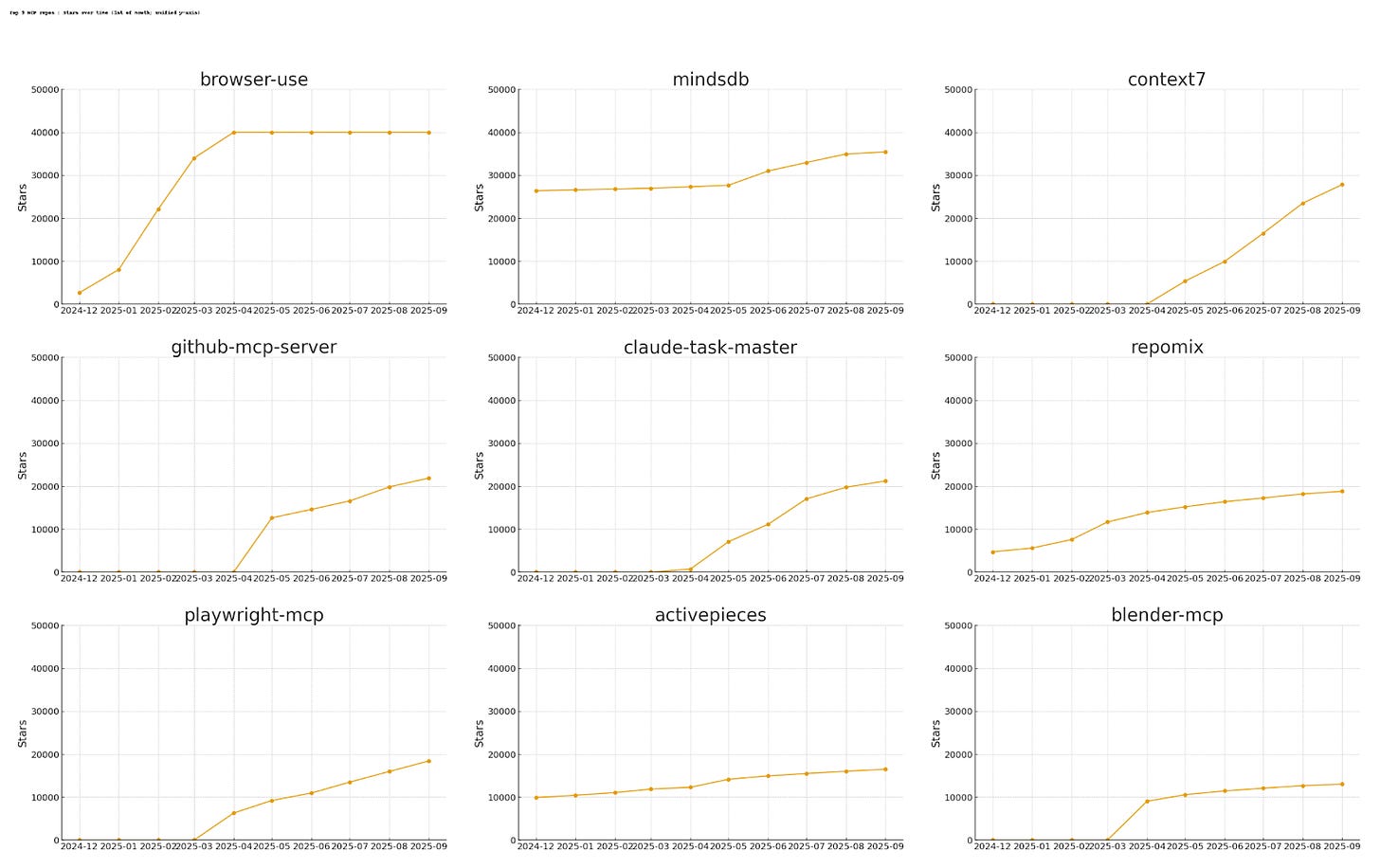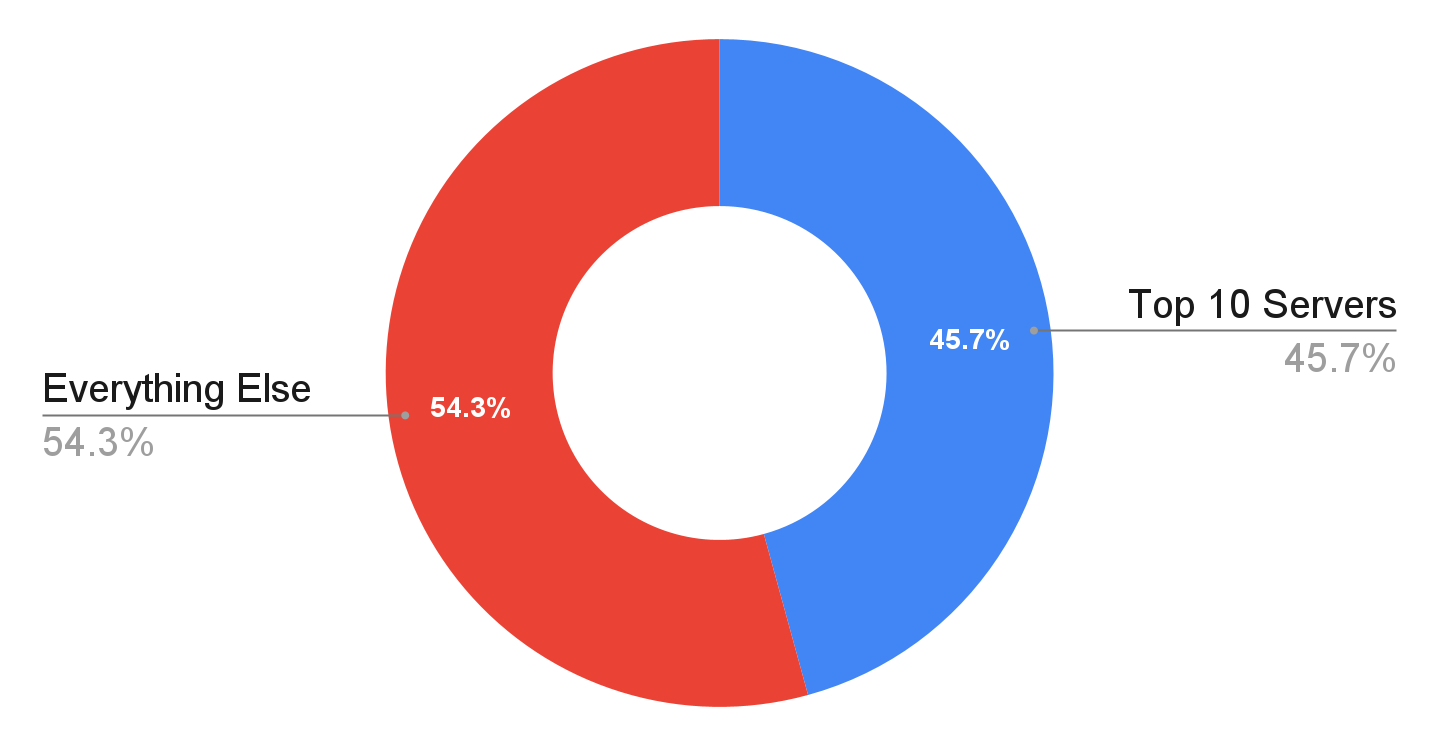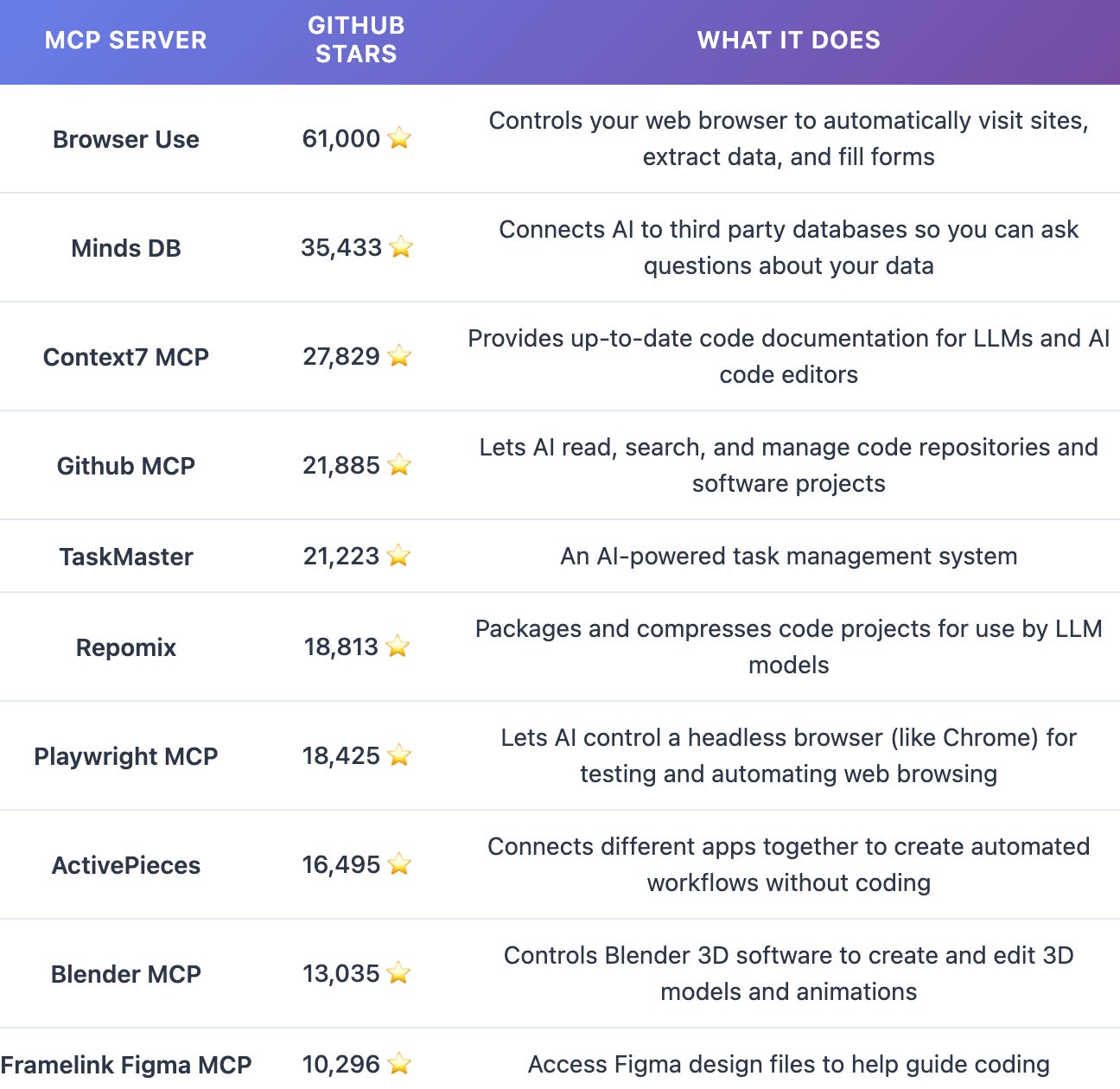Read, Write, Act: Inside the MCP server boom
A mapping of 2,874 MCP servers shows concentration risks and a surge in agentic browsing — with implications for APIs, local MCPs, and market design.
The Rise and Rise of MCP
Anthropic’s Model Context Protocol (MCP) was released in November 2024 as a way to make tools and platforms model-agnostic. MCP works by defining servers and clients. MCP servers are local or remote endpoints where tools and resources are defined. For example, GitHub released an MCP server that allows LLMs to both read from and write to GitHub. MCP clients are the connection from an AI application to MCP servers — they allow an LLM to interact with context and tools from different servers. An example of an MCP client is Claude Desktop, which allows the Claude models to interact with thousands of MCP servers.
In a relatively short time, MCP has become the backbone of hundreds of AI pipelines and applications. Major players like Anthropic and OpenAI have built it into their products. Developer tools such as Cursor (a coding-focused text editor or IDE), and productivity apps like Raycast, also use MCP. Additionally, thousands of developers use it to integrate AI models and access external tools and data without having to build an entire ecosystem from scratch.
In previous work published with AI Frontiers, we argued that MCP can act as a great unbundler of “context” – the data that helps AI applications provide more relevant answers to consumers. In doing so, it can help decentralize AI markets. We argued that for MCP to truly achieve its goals, however, it requires support from:
Open APIs: so that MCP applications can access third-party tools for agentic use (write actions) and context (read).
Fluid memory: Interoperable LLM memory standards, accessed via MCP-like open protocols, so that the memory context accrued at OpenAI and other leading developers does not get stuck there, preventing downstream innovation.
We expand upon these two points in a recent policy note for those looking to dig deeper.
More generally, we argue that protocols, like MCP, are actually foundational “rules of the road” for AI markets, whereby open disclosure and communication standards are built into the network itself, rather than imposed after the fact by regulators. Protocols are fundamentally market-shaping devices, architecting markets through the permissions, rules, and interoperability of the network itself. They can have a big impact on how the commercial markets built on top of them function too.
But How Is the MCP Ecosystem Evolving?
Yet we don’t have a clear idea of the shape of the MCP ecosystem today. What are the most common use cases of MCP? What sort of access is being given by MCP servers and used by MCP clients? Is the data accessed via MCP “read-only” for context, or does it allow agents to “write” and interact with it — for example, by editing files or sending emails?
To begin answering these questions, we look at the tools and context that AI agents use via MCP servers. This gives us a clue about what is being built and what is getting attention. In this article, we don’t analyze MCP clients — the applications that use MCP servers. We instead limit our analysis to what MCP servers are making available for building.
We assembled a large dataset of MCP servers (n = 2,874), scraped from Pulse MCP. We then enriched it with GitHub star-count data on each server.1 On GitHub, stars are similar to Facebook “likes,” and developers use them to show appreciation, bookmark projects, or indicate usage.
In practice, while there were plenty of MCP servers, we found that the top few garnered most of the attention and, likely by extension, most of the use. Just the top 10 servers had nearly half of all GitHub stars given to MCP servers.
Some of our takeaways are:
MCP usage appears to be fairly concentrated. This means that, if left unchecked, a small number of servers and (by extension) APIs could have outsized control over the MCP ecosystem being created.
MCP use (tools and data being accessed) is dominated by just three categories: Database & Search (RAG), Computer and Web Automation, and Software Engineering. Together, they received nearly three-quarters (72.6%) of all ‘stars’ on GitHub (which we proxy for usage).
Most MCP servers support both read (access context) and write (changing context) operations, showing that developers want their agents to be able to act on context, not just consume it.
MCP Server Use Is Highly Concentrated
To start with, we analyzed the MCP ecosystem for concentration risk.
We found that MCP usage is fairly concentrated among several key MCP Servers, judged by how many GitHub stars each repo received.
Despite there being thousands of MCP servers, the top 10 servers make up nearly half (45.7%) of all GitHub stars given to MCP servers (pie chart below) — and the top 10% of servers make up 88.3% of all GitHub stars (not shown).
This means that the majority of real-world MCP users are likely relying on the same few services made available via a handful of APIs. This concentration likely stems from network effects and practical utility: all developers gravitate toward servers that solve universal problems like web browsing, database access, and integration with widely used platforms like GitHub, Figma, and Blender. This concentration pattern seems typical of developer-tool ecosystems. A few well-executed, broadly applicable solutions tend to dominate. Meanwhile, more specialized tools occupy smaller niches.
The Top 10 MCP Servers Really Matter
Next, the top 10 MCP servers are shown in the table below, along with their star count and what they do:
Among the top 10 MCP servers, GitHub, Repomix, Context7, and Framelink are built to assist with software development: Context7 and Repomix by gathering context, GitHub by allowing agents to interact with projects, and Framelink by passing on the design specifications from Figma directly to the model. The Blender server allows agents to create 3D models of anything, using the popular open-source Blender application. Finally, Active Pieces and MindsDB connect the agent to multiple APIs with one standardized interface; in MindsDB’s case, primarily to read data from databases, and Active Pieces to automate services.
The dominance of agentic browsing, in the form of Browser Use (61,000 stars) and Playwright MCP (18,425 stars), stands out. This reflects the fundamental need for AI systems to interact with web content. These tools allow AI to navigate websites, click buttons, fill out forms, and extract data just like a human would. Agentic browsing has surged even though it’s far less token-efficient than calling an API. Browsing agents often need to wade through multiple pages of boilerplate to extract slivers of data a single API request could return. Because many services lack usable APIs or tightly gate them, browser-based agents are often the simplest—sometimes the only—way to integrate, underscoring the limits of today’s APIs.
At a deeper level, the repos which currently dominate MCP servers highlight three encouraging facts about the MCP ecosystem:
First, several prominent MCP servers support multiple third-party services for their functionality. MindsDB and Active Pieces serve as gateways to multiple (often competing) service providers through a single server. MindsDB allows developers to query different databases like PostgreSQL, MongoDB, and MySQL through a single interface, while Taskmaster allows the agent to delegate tasks to a range of AI models from OpenAI, Anthropic, and Google, all without changing servers.
Second, agentic browsing MCP servers are being used to get around potentially restrictive APIs. As noted above, Browser Use and Playwright access internet services through a web browser, helping to bypass API restrictions, but they instead run up against anti-bot protections. This circumvents the limitations that APIs can impose on what developers are able to build.
Third, some MCP servers do their processing on the developer’s computer (locally), making them less dependent on a vendor maintaining API access. Some MCP servers examined here can run entirely on a local computer without sending data to the cloud, meaning no gatekeeper has the power to cut you off. Out of the 10 MCP servers examined above, only Framelink, Context7, and GitHub rely on just a single cloud-only API dependency that can’t be run locally end-to-end on your machine. Blender and Repomix are completely open-source and don’t require any internet access for them to work, while MindsDB, Browser Use, and Active Pieces have local, open-source implementations.
The Three Categories That Dominate MCP Use
Next, we grouped MCP servers into different categories based on their functionality.
When we analyzed what types of servers are most popular, we found that three dominated: Computer & Web Automation (24.8%), Software Engineering (24.7%), and Database & Search (23.1%).

Widespread use of Software Engineering (24.7%) MCP servers aligns with Anthropic’s economic index, which found that an outsized portion of AI interactions were software development related.
The popularity of both Computer & Web Automation (24.8%) and Database & Search (23.1%) also makes sense. Before the advent of MCP, web scraping and database search were highly integrated applications across platforms like ChatGPT, Perplexity, and Gemini. With MCP, however, users can now access that same search functionality and connect their agents to any database with minimal effort. In other words, MCP’s unbundling effect is highly visible here.
Agents Interact With Their Environments
Lastly, we analyzed the capabilities of these servers: are they allowing AI applications just to access data and tools (read), or instead do agentic stuff with it (write).
Across all but two of the MCP server categories looked at, the most popular MCP servers supported both reading (access context) and writing (agentic) operations – turquoise color. The prevalence of servers with combined read and write access suggests that agents are not being built just to answer questions based on data, but also to take action and interact with services on a user’s behalf.

The two exceptions are Database & Search (RAG) and Finance MCP servers, in which read-only access is a common permission given. This is likely because data integrity is critical, ensuring that the data in question remains reliable.
The Importance Of Multiple Access Points
A few implications of our analysis can be drawn out at this preliminary stage.
First, concentrated MCP server use compounds the risks of API access being restricted. As we discussed in Protocols and Power, MCP remains constrained by “what a particular service (such as GitHub or Slack) happens to expose through its API.” A few powerful digital service providers have the power to shut down access to their servers.
One important hedge against API gatekeeping is that many of the top servers try not to rely on a single provider. In addition, the following two safeguards are relevant:
Offer local processing of data on a user’s machine whenever possible, instead of sending the data for processing to a third-party server. Local processing ensures that functionality cannot be restricted.
If running a service locally is not possible (e.g., email or web search), the server should still support multiple avenues of getting at the needed context through using competing APIs. For example, MindsDB functions as a gateway to multiple data sources; so instead of relying on just one database to read and write data, it goes to great lengths to support multiple databases in one unified interface, essentially making the backend tools interchangeable.
Second, our analysis points to the fact that current restrictive API access policies are not sustainable. Web scraping and bots, accessed via MCP servers, are probably being used (at least in part) to circumvent overly restrictive API access, complicating the increasingly common practice of banning bots. Even OpenAI is coloring outside the API lines, using a third-party service to access Google Search’s results through web scraping, thereby circumventing its restrictive API.
Expanding structured API access in a meaningful way is vital. This ensures legitimate AI automation runs through stable, documented endpoints. Otherwise, developers resort to brittle browser automation where privacy and authorization have not been properly addressed. Regulatory guidance could push the market in this direction, as with open banking in the U.S.
Finally, encouraging greater transparency and disclosure could help in getting a sense of where the bottlenecks are in the MCP ecosystem.
Developers operating popular MCP servers (above a certain usage threshold) or providing APIs used by top servers should try to report usage statistics, access denials, and rate-limiting policies. This data would help regulators identify emerging bottlenecks before they become entrenched. GitHub might facilitate this by encouraging these disclosures, for example.
Additionally, MCP servers above certain usage thresholds should aim to clearly list their dependencies on external APIs and what fallback options exist if the primary APIs become unavailable. This is not only helpful in determining the market structure, but also essential information for security and robustness for downstream applications.
The goal is not to eliminate all concentration in the network, but to ensure that the MCP ecosystem remains contestable, with multiple viable paths for innovation and user choice. By addressing both technical architecture and market dynamics, these suggested tweaks could help MCP achieve its potential as a democratizing force in AI development, rather than merely shifting bottlenecks from one layer to another.
Appendix
Dataset
The full dataset, along with descriptions of the categories, can be found here (constructed by Sruly Rosenblat):
https://huggingface.co/datasets/sruly/MCP-In-Practice
Limitations
There are a few limitations to our preliminary research:
GitHub stars aren’t a measure of download counts or even necessarily a repo’s popularity.
Only the name and description were used when categorizing repos with the LLM.
Categorization was subject to both human and AI errors and many servers would likely fit into multiple categories.
MCP Server Use Over Time

For this analysis, we categorized each repo into one of 15 categories using GPT-5 Mini. We then human-reviewed and edited the top 50 servers that make up around 70% of the total star count in our dataset.








